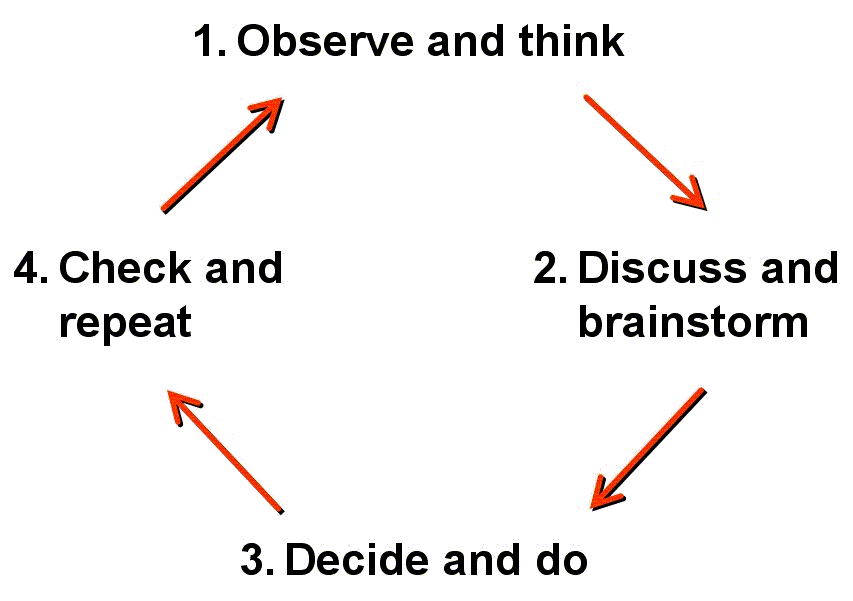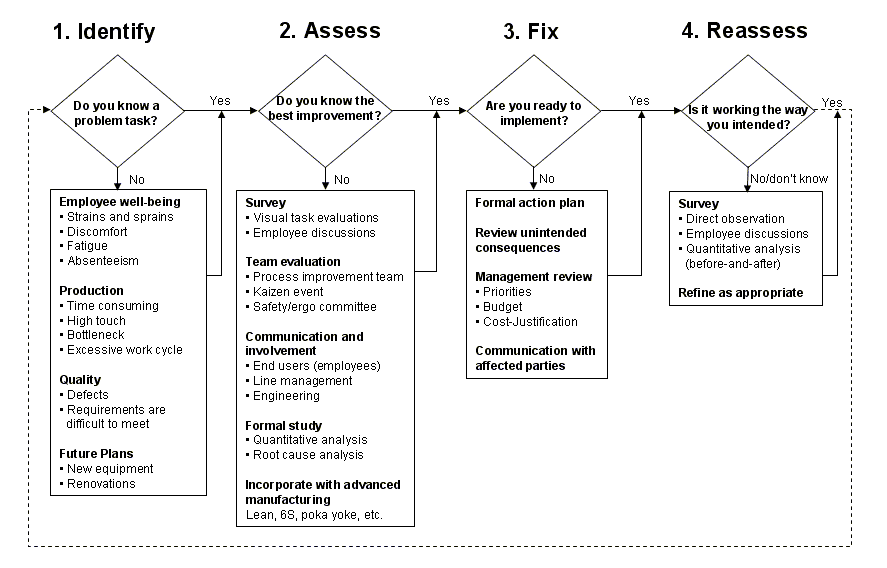 |
| Putting on your ergonomics glasses |
Ergonomics does not need to be difficult. Certainly there are complex and highly rigorous aspects of the field that must be done by Ph.D.s in laboratories and universities. However, much can be done in the workplace by ordinary people with a little bit of training, common sense, and good thinking. Sometimes, all that is needed to get started is to “put on your ergonomics glasses” to see the everyday issues that surround you from a new perspective.
The basic process
 Be systematicThe basic process is simple and is repeated daily by countless supervisors, engineers, and ordinary workers without knowing they are following a “process.” Rather than doing a job mindlessly, you think about what it is that you are doing, think about alternatives (often by kicking ideas around with other people), changing what you can, and reflecting if it is working the way you intended, and if not, how to fine tune the improvement.
Be systematicThe basic process is simple and is repeated daily by countless supervisors, engineers, and ordinary workers without knowing they are following a “process.” Rather than doing a job mindlessly, you think about what it is that you are doing, think about alternatives (often by kicking ideas around with other people), changing what you can, and reflecting if it is working the way you intended, and if not, how to fine tune the improvement.
The goal of the ergonomics process is to become systematic with these efforts.
- Evaluate tasks methodically — for example: What jobs are especially difficult to perform? What jobs are bottlenecks in production? What jobs are planned to be reorganized or renovated?
- Upgrade people’s skills in evaluating tasks by providing basic information on the principles of ergonomics.
None of this needs to be difficult or complicated. There are times when it is necessary to be more sophisticated (see below), but often the process just amounts to being more organized than what has typically been done in the past.
A Low-Tech Process for Solving Problems

Observe and think |
|
Discuss and brainstorm |
|
Decide and do |
|
Check and repeat |
|
A more formal approach
The basic process above can be expanded, including using more formal terms. The idea is the same — if you already know the problem, how to fix it, and can make the changes and reassessment, then the process is simple. However, if at any point, you do not know exactly what should be done, or if you want to be systematic across an entire workplace, then there are additional steps that you may need to take.
 The point is that ergonomics can be done simply or may involve complexity, depending upon the circumstances. The model shows these parallel modes.It may take some study to identify a problem, such as understanding human-related causes of defects, or tasks associated with strains and sprains. Or the full evaluation of the problem and the options for improvement might involve a full kaizen event or quantitative analysis. Thus, the flow chart shows a loop at each step that depends on the situation.
The point is that ergonomics can be done simply or may involve complexity, depending upon the circumstances. The model shows these parallel modes.It may take some study to identify a problem, such as understanding human-related causes of defects, or tasks associated with strains and sprains. Or the full evaluation of the problem and the options for improvement might involve a full kaizen event or quantitative analysis. Thus, the flow chart shows a loop at each step that depends on the situation.
Production, quality, safety
This model emphasizes production and quality issues, plus prevention of strains and sprains. Ergonomics has achieved visibility in much of business and industry because of its value in helping prevent these types of injuries, but the field involves more than safety. It constitutes a method for improving quality and productivity in its own right.
Thus, the ergonomics process can be triggered by a variety of human-related issues besides injuries. Examples include:
- Excessive touch time
- Defects that are human-related
- The learning curve for doing a difficult task is too steep
The model also highlights the importance of integrating ergonomics with the other tools of advanced manufacturing, such as Lean Manufacturing, 5S, and mistake proofing. These tools work best when employed synergistically, not independently.
Additional information
This tutorial provides a good introduction, but there is much more — too much to be included on a website. A full length book by the author of this website is available: The Ergonomics Kit for General Industry (Taylor & Francis, 2006). This book is a “how to” manual on setting up practical workplace ergonomics programs and contains best organizational practices developed over a lifetime of consulting experience. It is complete with electronic worksheets, planning guides, and training support materials, as well as detailed case studies of the workplace ergonomics process in action.

